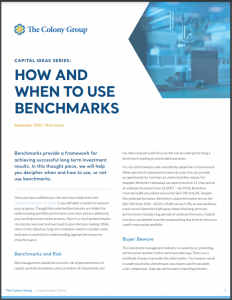How and When to Use Benchmarks
Benchmarks provide a framework for achieving successful long term investment results. In this thought piece, we will help you decipher when and how to use, or not use benchmarks.
Once you have codified your risk and return objectives (see Threshold Questions for Families), you will want a system to measure your progress. Thoughtfully selected Benchmarks are helpful for understanding portfolio performance over time and are additive to your portfolio construction process. There is a risk that benchmarks can also be overused and even lead to poor decision-making. While return is the objective, long-term investors need to consider costs and taxes as essential to understanding appropriate measures of performance.
Benchmarks and Risk
Risk management should focus on the risk of permanent loss of capital, portfolio drawdown, and correlation of investments, but too often investors will focus on the risk of underperforming a benchmark, leading to unintended outcomes.
It is rare that investors will consistently outperform a benchmark. When periods of underperformance do arise, this can provide an opportunity for investors to understand the reason. For example, Berkshire Hathaway has experienced an 11-year period of underperformance from 12/2007 – 06/2018. Berkshire returned 6.8% annualized versus the S&P 500 of 8.3%. Despite this underperformance, Berkshire’s outperformance versus the S&P 500 from 1965- 2022 is 19.8% versus 9.9%, an extraordinary track record. Berkshire Hathaway shows that long-term out performance includes long periods of underperformance. Patient investors can benefit from the compounding (tax free) of returns in a well-constructed portfolio.
Buyer Beware
The investment management industry is masterful at presenting performance numbers in the most favorable way. There are a multitude of ways to provide this information. The investor needs to understand why a benchmark was chosen and if it provides a fair comparison. Typically, performance reporting includes footnotes that provide important information in small print. Always take a moment to read the footnotes and understand what they mean.
Net Returns versus Gross Returns
Gross returns should be discounted. Net returns after fees are the only returns that an investor should consider. Returns after tax are even more important but rarely provided as a measure.
Alpha Generation versus Beta
In today’s market, many investors seek inexpensive beta through passive investing. There are plenty of ways to generate alpha (excess return over beta). Alpha generation is the value added by great investment managers and still exists for a discerning investor with patience and access. Here are some examples of asset classes that can provide alpha, venture capital, private equity, small- and mid-cap U.S. and international, country specific allocation, and certain alternative investments.
High Tracking Error
Outperformance, or alpha generation, comes from truly differentiated investing that can cause high tracking error with an index. Tracking error is a measure of fluctuations around an index trend line. Many managers and advisors will avoid the risk of high tracking error because they risk losing clients during periods of underperformance.
Closet Indexing
“Closet indexing” is a common theme in investment management. Managers will seek to “hug” the benchmark in the hopes of marginal improvement versus the benchmark. They will do this by minor over or underweights to sectors that comprise the index, generating low tracking error. The outcome can be a modest under or outperformance with less tax efficiency.
Chasing the Hot Dot
Assessing investment managers’ recent performance often drives decisions. A thoughtful investor will try to discern if the manager was lucky or skillful. The adage “don’t confuse brains with a bull market” is often true; many investors are tempted to chase the hot manager when it is a bull market they are chasing. It is important to understand what drove the successful track record. Was there a clear and repeatable process? What produced the returns? Was it a specific opportunity set combined with appropriate implementation or luck? The most important question: is the good news already priced in?
Is it Better to Be a Contrarian?
Sophisticated investors will often seek great managers when they underperform. This contrarian approach requires looking beyond the bad news and having an appreciation for whether the bad news is already reflected in prices. This can be the best entry point. Your asset manager should be able to discern the difference between chasing the “hot dot” and the great manager who is experiencing a period of underperformance.
Benchmark Agnostic
Benchmark agnostic is a compelling concept but hard to deliver. It supports the notion that benchmarks are overused and underscores the need for good investing. Despite a managers stated intention, they will be aware of their relative performance.
When to Not Use a Benchmark?
As noted, over reliance on benchmarks can lead to poor decision-making. It can cause investors to get out when patience will be rewarded or stay too long when an investment value proposition has broken down.
2010-2022 was a period in the fixed income market when performance comparisons lead to poor decisions. Federal Reserve policies kept interest rates low for an extended period that did not allow for proper market pricing of fixed income investments. During this time, the Barclay’s Aggregate Index was extending duration, not by choice, but by the compounding of extremely low rates, 1% or less. In 2010 the duration of the Barclays Aggregate Index was 4.0 years and by 2021 it was 6.3 years. The risk of rising rates on the Barclays Aggregate Index increased by more than 50% over 10 years meaning it had greater risk if rates were to rise.
An alternative to fixed income over the past decade would have been a portfolio of “cash on cash” investments with low correlation to financial assets. This type of investment has idiosyncratic cash flow characteristics which makes benchmarking hard to do (see Pivoting Away From Traditional Fixed Income). In this case, an investor might prefer to use a measure of absolute return.
Hedge funds are meant to generate strong returns with lower risk. Over the years the assumption was hedge funds would provide 70% of the S&P 500 return with half the volatility (measured by standard deviation). Over the past 10 years, this has not been the case. One benchmark used to measure hedge fund performance, the HFRI Weighted Composite Index, provided an annualized return of 4.4% over 10 years (ending 03/31/2023) versus 12.2% annualized for the S&P 500 over the same period. This index shows hedge funds providing 36% of S&P 500 returns. In several cases, hedge fund volatility (standard deviation) was closer to the S&P 500 of 16%. This comparison shows the risk reward is out of balance and calls into question the investment and the benchmark.
Private Equity Returns and Incentive Fees
Investors in private equity are drawn by impressive long-term returns. Private equity invests capital over the long-term with many funds returning capital over a 7–12-year time. Investors can benefit from the illiquidity of private equity because it requires a long-term commitment. As a baseline, the investor should expect alpha (excess returns over an index) of at least 5% annualized over an appropriate benchmark as compensation for illiquidity.
When an investor considers private equity investments, there are numerous conventions around fees, carried interest, preferred returns, and hidden expense calculations, that all must be considered. Unfortunately, many private placement memorandums present this information in a way that is not easy to understand. Ask your asset manager to explain the details.
Private equity returns are expressed by internal rate of return (IRR) and multiple on invested capital (MOIC). Private equity managers can manage IRRs to reflect attractive returns. MOIC is a direct measure of how much money the investor has made. Here are two examples to consider: one manager produced an IRR of 20%, had a MOIC of 1.6 times which annualized at 4.3% better than the benchmark. The other manager produced a 9.3% IRR, a 1.2 times MOIC which was 32.4 % better return annualized than the benchmark. IRR is dependent on the time of the capital deployed. The takeaway? If you only saw IRR, you may select the first manager over the second manager. The first manager’s 20% IRR is an attractive number but the capital was deployed for a short period of time, as reflected in the modest MOIC. The second manager outperformed the benchmark at a time with the sector was performing poorly. The positive return and excess outperformance would indicate that the second manager generated considerably more alpha versus the benchmark.
What Benchmarks to Use?
There are almost as many benchmarks as there are investments. Please speak with your asset manager to determine which are the most appropriate benchmarks for your portfolio.


